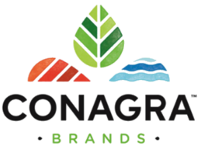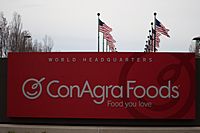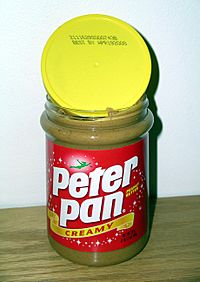Conagra Brands facts for kids
 |
|
|
Formerly
|
|
|---|---|
| Public | |
| Traded as | |
| Industry | Food processing |
| Founded | 1919 |
| Founder | Alva Kinney |
| Headquarters | Merchandise Mart Chicago, Illinois, U.S. |
|
Area served
|
Worldwide |
|
Key people
|
Sean Connolly (CEO) |
| Brands | List of Conagra brands |
| Revenue | |
|
Operating income
|
|
| Total assets | |
| Total equity | |
|
Number of employees
|
c. 18,500 (2024) |
| Footnotes / references Financials as of May 26, 2024[update]. |
|
Conagra Brands, Inc. is a big American company that makes and sells many popular food products. You can find their items in supermarkets, restaurants, and food service places. The company is based in Chicago, Illinois. Conagra makes food under many different brand names.
Conagra's Story
How Conagra Started (1919–1949)
Conagra began in September 1919. It was first called Nebraska Consolidated Mills (NCM). Alva Kinney started the company. It was a group of four grain milling companies. Their first main office was in Grand Island, Nebraska.
In 1922, NCM moved its main office to Omaha, Nebraska. This happened after they bought another mill. That year, NCM made its first profit of $175,000. In 1941, the company opened its first plant outside Nebraska. This plant was in Decatur, Alabama.
Growing and Changing (1950–1970)
NCM looked for new ways to use its flour. In 1951, they helped start the Duncan Hines brand. This brand made cake mixes to sell more flour. NCM sold Duncan Hines in 1956. In 1957, NCM built its first mill outside the U.S. mainland. This mill was in Puerto Rico. Conagra Brands bought the Duncan Hines brand back in 2018.
Becoming ConAgra (1971–1999)
NCM changed its name to ConAgra in 1971. The name combines Latin words. "Con" means "with" and "agri" means "soil" or "earth." Two years later, the company became public. This meant its shares could be bought and sold on the NYSE.
In 1974, ConAgra faced tough times. They hired C. Michael Harper to help the company. Harper started selling buildings and parts of the company that were not needed. He wanted ConAgra to focus on basic food items. By 1976, Harper had sold 25 assets. He also lowered the company's debt by $35 million. In 1981, ConAgra's sales reached over $1 billion for the first time.
ConAgra bought about 200 companies over 20 years. These included Banquet Foods in 1980 and Armour and Company in 1983. They also bought Beatrice Foods in 1990. After buying Monfort and Beatrice, ConAgra became very large. It was the world's biggest meatpacker. It was also the second-largest food processor. During this time, the company created the Healthy Choice brand. This brand offered a line of frozen dinners.
By the mid-1980s, ConAgra was involved in many parts of the food business. They sold fertilizer, tires, and clothing. They also had companies for farming, exporting, and trading.
ConAgra faced some legal challenges during this period. In 1987, ConAgra wanted to build a new main office in Omaha. This meant tearing down the Jobbers Canyon Historic District. This area was a historical site. Many groups did not want it torn down. But the city allowed it, and the district was removed in 1989.

By 1992, ConAgra's yearly sales were over $21 billion. The company kept buying other companies and launching new products. They added Marie Callender's frozen products in 1994. In 1998, ConAgra bought several brands from RJR Nabisco. These included Egg Beaters and margarines like Parkay and Blue Bonnet.
From Meat to Packaged Foods (2000–2015)
In 2000, ConAgra changed its name to ConAgra Foods. In the early 2000s, the company sold its fresh and refrigerated meat businesses. This included selling most of its share in Swift & Company in 2002. This sale ended ConAgra's part in the fresh beef and pork industries. In 2006, the company sold its refrigerated meats. These included Butterball and Eckrich.
In 2008, ConAgra bought Watts Brothers Farms. In 2012, they bought Ralcorp. Also in 2012, ConAgra bought the P.F. Chang's and Bertolli food brands. In 2014, ConAgra bought TaiMei Potato Industry Limited. This was a potato processor in Inner Mongolia. ConAgra sold Ralcorp in 2015. They also bought Blake's All Natural Foods that same year. In 2016, ConAgra separated Lamb Weston into its own company.
During these years, ConAgra also faced some concerns about its environmental practices. The company also had some issues regarding worker treatment.
Moving to Chicago (2016–Present)
In 2016, Conagra moved its main office to Chicago, Illinois. They also changed their name to "Conagra Brands."
On September 22, 2017, Conagra announced it was buying Angie's Artisan Treats. This company makes Angie's Boomchickapop popcorn. The deal was finished on October 23, 2017.
On June 27, 2018, Conagra Brands announced it would buy Pinnacle Foods for $8.1 billion. This purchase was completed on October 26, 2018.
On December 8, 2020, Conagra announced it was selling the Peter Pan brand. This sale was completed on January 25, 2021.
In June 2021, Conagra said it would use only cage-free eggs by 2024. In February 2022, ConAgra paid $18 million to settle a lawsuit. This lawsuit was from food-processing workers in California. They said the company had not followed California wage laws.
Conagra's Products
Conagra makes many different food products. These include cooking oil, frozen dinners, hot cocoa, hot dogs, and peanut butter. Some of their well-known brands are Act II, Hunt's, Healthy Choice, Marie Callender's, Orville Redenbacher's, Slim Jim, Reddi-wip, Egg Beaters, Pam, Angie's Boom Chicka Pop, Hebrew National, Chef Boyardee, and Bertolli ready meals.
Company Information
As of 2023, Conagra has 38 factories in the United States. They employ about 18,600 people. In the 2023 fiscal year, their sales were $12.27 billion. The company is part of the Fortune 500 list. This list includes the largest companies in the U.S. Sean M. Connolly is the company's president and chief executive officer.
Product Safety Incidents

2002 E. coli Outbreak
In July 2002, Conagra recalled 19 million pounds of ground beef. This was because of E. coli bacteria. This meat was linked to illnesses in 19 people across six states.
2006–2007 Salmonella Outbreak
In February 2007, Conagra recalled jars of Peter Pan and Great Value brand peanut butter. These jars had the product code "2111" on the lid. They were linked to a Salmonella outbreak. The Centers for Disease Control and Prevention (CDC) reported that over 628 people got sick. These illnesses were in 47 states and linked to the peanut butter. About 20% of those who got sick had to go to the hospital. No deaths were reported.
Since Peter Pan peanut butter is made at only one plant, the recall included all Peter Pan jars sold in the U.S. between May 2006 and February 2007.
Diacetyl in Popcorn
On September 4, 2007, a group of flavor makers suggested reducing diacetyl in butter-like flavorings. This is because of a lung disease called bronchiolitis obliterans. This disease, also known as "Popcorn Workers's Lung," affected plant workers exposed to diacetyl fumes. It also affected one popcorn consumer. The next day, ConAgra Foods said it would remove diacetyl from its Jiffy Pop and Orville Redenbacher's popcorn products soon.
2007 Salmonella Outbreak (Pot Pies)
In October 2007, Conagra asked stores to remove Banquet and generic brand chicken and turkey pot pies. This was because 152 cases of Salmonella poisoning were linked to these pot pies. These cases were in 31 states, and 20 people went to the hospital.
At first, ConAgra said the problem was from pies not being cooked enough in older microwaves. They planned to change the cooking instructions. However, the plant where the pot pies were made closed on October 11.
By October 12, a full recall was announced. It included all varieties of frozen pot pies sold under many brands. These included Banquet, Albertson's, Food Lion, Great Value, Kroger, and others. The recalled pot pies were in 7-oz. single-serving packages. They had the number P-9 or "Est. 1059" printed on the side. By October 14, 174 cases of Salmonella poisoning were linked to the pot pies. These cases were in 32 states, and 33 people were hospitalized. Public groups criticized Conagra for waiting to issue the recall. Conagra said the recall was a safety step. By the end of 2007, the CDC identified 401 cases in 41 states linked to these pot pies.
See also
 In Spanish: Conagra Brands para niños
In Spanish: Conagra Brands para niños
- 2009 ConAgra Foods Plant explosion

